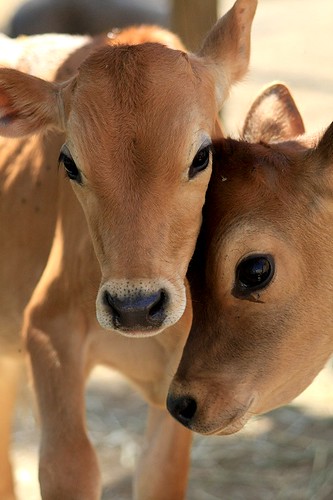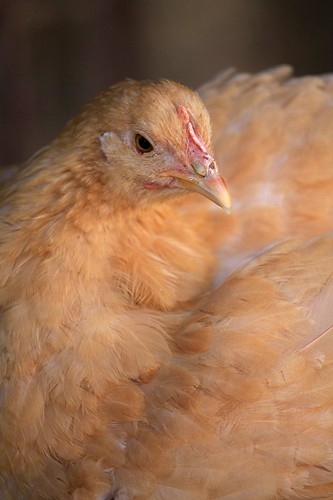During the California State Fair, a pregnant cow escaped prior to the fair opening and was eventually shot and killed. The cow was part of the live birth exhibit in which heavily pregnant animals are transported from farms and forced to give birth in front of spectators.
Every year, thousands of cows, goats, sheep and pigs are transported during the last 10% of their pregnancy to be part of live birth exhibits at both county and state fairs. While supporters claim these offer educational insight on the "miracle of birth", there is no scientific study to support that claim. There is, however, ample evidence that the transport of heavily pregnant animals is damaging to the health and welfare of both mother and offspring. Further, cows and pigs prefer giving birth in solitude, not in public, yet they cannot escape gawking onlookers at the fair.
Pregnant sows (pigs) are confined in crates so small they cannot turn around. These farrowing crates severely restrict the sow's movement. Supporters claim this will prevent her from eating or crushing the piglets, yet somehow pigs on free-range operations and at sanctuaries manage to avoid doing this.
The welfare concerns of live birth exhibits significantly outweigh any educational value the public may have. The shooting death of the pregnant cow at the California State Fair only highlights the underlining issue, that pregnant animals should not be transported and put on display during the sensitive, stressful birthing process.
Tell the California State Fair Board that live birth exhibits have no place at the State Fair.
Sign the petition today!
Animal Place Photo Flashback - Summer and Freedom

August 8, 2009
This is an iconic shot of Summer and Freedom, two male calves rescued from auction. Like all dairy calves, Summer and Freedom were deprived of their mother, having been taken away from her right after birth. Here, they take comfort in one another. They are a little older than two months in this photo.
You can have your own copy of this beautiful photo. Each photo is matted on 11x17 archival quality mat. The photo is 8x10" and full color. Buy one here and support the efforts of Animal Place.
Animal Place Photo Flashback - Frank Potbelly Pig

Photo: August 7, 2009
Frank is one of 7 potbellied pigs at the sanctuary. He arrived in 2004 along with two other pigs. They came from a southern California neglect case. A man had 6 pigs and in two years, he ended up with 300 on less than an acre of land.
It takes a full five years for potbellied pigs to reach their full size. Potbellied pigs can make wonderful companions, but require extensive and often specialized care. Obesity and arthritis are a constant concern. Do your research before adopting one.
Labels:
pictures,
potbellied pigs,
sanctuary residents
Animal Place Photo Flashback - Copper Chicken

Photo: August 6, 2010
Copper is a gold-laced orpington, another breed popular with backyard chicken enthusiasts. Like many chickens at the sanctuary, Copper is the result of the backyard chicken craze. She and three other orpingtons were purchased as chicks from a feed-store. These chicks came from a large hatchery where they were born in an incubator, not in a nest. Their parents live in small cages and are used as breeding machines.
Chickens were illegal where the woman lived. While chickens make wonderful companion animals, it is important to do proper research before bringing one home. Adopt chickens - don't buy from a feed-store or a hatchery.
Labels:
chickens,
pictures,
sanctuary residents
Animal Place Photo Flashback - Boris Rabbit

Photo Taken: August 5, 2009
Boris is one of more than a hundred rabbits rescued from a school-yard. Years ago, a teacher with a few intact rabbits decided they weren't worth the effort. Instead of finding placement for them, this educator taught a bad lesson - she released them on the school grounds. Soon the place became a dumping ground for unwanted rabbits. Rampant breeding led to an explosion in the population. School officials wanted to kill the rabbits, but rescuers intervened and achieved a legal victory. Instead of death, rescuers would capture the rabbits, neuter them, and place them into homes or sanctuaries. Animal Place took in seven.
Rabbits can make wonderful companions, but it is important to research their care first. They prefer a less hands-on approach to their care and, as prey animals, can perceive being held as an attack. They do best with older children and adults, as most rabbits do not enjoy the grabby and often frenetic energy of young children. They can live 8-12 years and a cage should NEVER be their primary method of confinement.
Labels:
pictures,
rabbits,
sanctuary residents
Will Tuttle Speaks About Animal Place
Will Tuttle, Ph.D, author of The World Peace Diet, visited Animal Place and shared his thoughts with us.
The spirit of Animal Place is compassion in action. Pigs here are finally free to wander, root, and relax on acres of beautiful land, and hens to dust bathe and socialize happily. Organic gardens, fields, and forests are woven thoughtfully with well-constructed new barns and fencing so that there is ample space for the cows, goats, rabbits, turkeys, and other animals who have been rescued from the violence of meat, dairy, and egg production.
This is a place of education also: both learning and unlearning. Seeing the unique and vivid personalities of the animals who are respected and treated as subjects rather than as objects, we can unlearn the delusions that contribute to our violence, and begin to understand our proper relationship with the Earth and her creatures, and with each other. Animal Place is a wondrous place for children—petting a little goat, rubbing a pig’s belly, and feeding the chickens and turkeys connects us all with the child within who naturally sees with eyes of inclusion.
Through the hard work and vision of founder Kim Sturla and the dedicated staff, and the generosity and foresight of thousands of contributors and volunteers, Animal Place has been able to move from over-cramped facilities in Vacaville to a magnificent 600 acres of water-rich land in Grass Valley in the foothills of the Sierra Nevada. Large enough for a wildlife sanctuary and a sanctuary for rescued farmed animals, there will also be educational programs to help people deepen their connection with their innate compassion and wisdom.
Visiting Animal Place is visiting the future: a future where we will all be more sensitive and aware of the interconnectedness of all life, and live a deeper understanding that life is a celebration, not a competition.
Animal Place is a community in the best sense – a place of cooperation and caring, of idealism and practicality—a vision of the best in humanity, and of the beautiful world we can create together as we awaken from the trance of exclusion and the illusion that might makes right. Animal Place is a place where we, as a culture, are growing exciting and positive new dreams together.
Animal Place Photo Flashback - Looloo Hen

Photo: August 4, 2009
Loo-loo turned one this year in May. She is one of many faces from the backyard chicken craze. When, as a young chick, she was no longer wanted, Loo-loo was set free. The poult wandered into a backyard where several feral cats ended up attacking her. The owners of the home took her in and cared for her wounds. When she was healthy, they contacted Animal Place. How could we say no? Loo-loo is a buff orpington, a breed of chicken raised for their flesh and sometimes eggs. At the sanctuary, Loo-loo gets to be herself. She is one of the friendlier chickens and enjoys sitting on laps.







